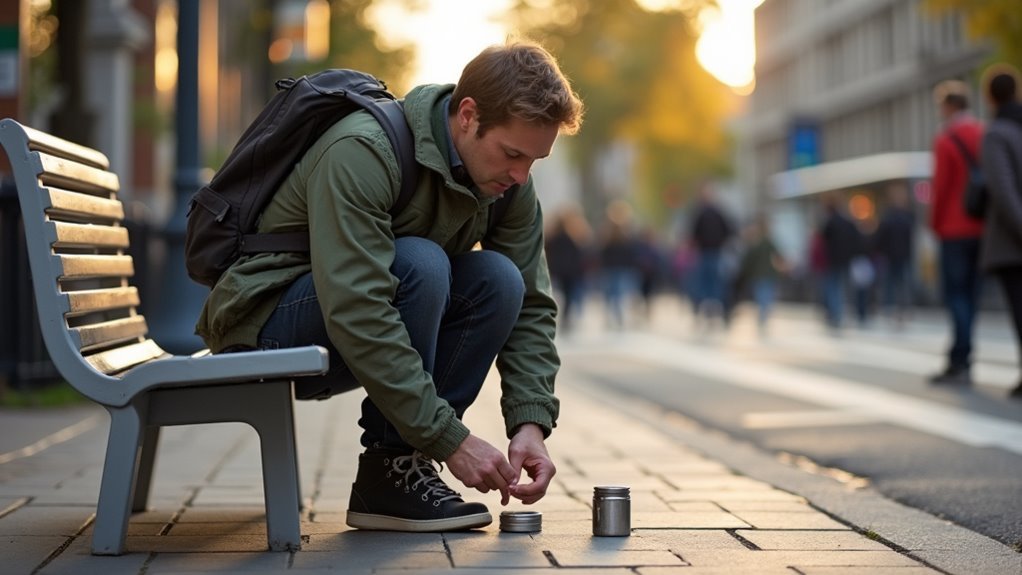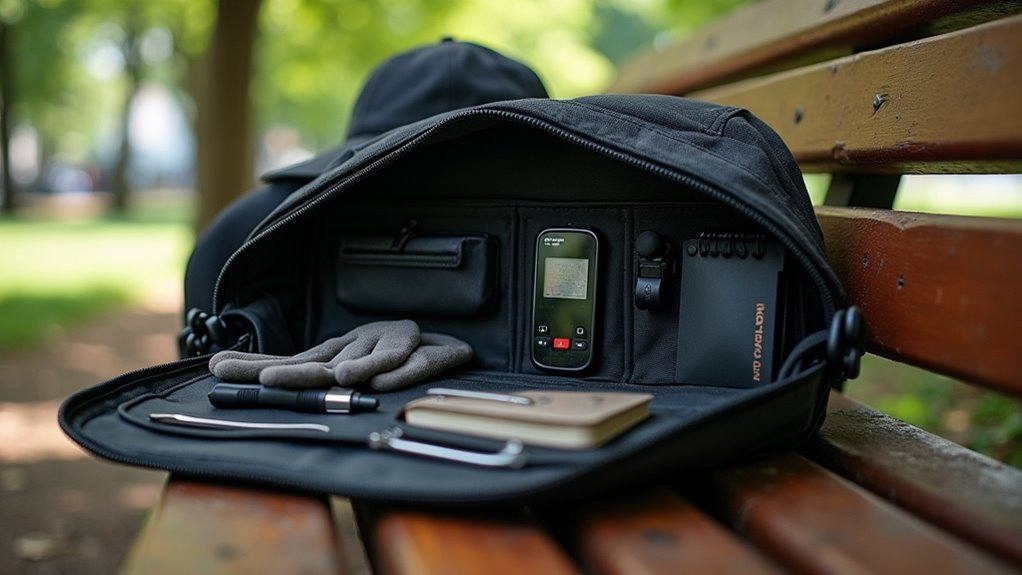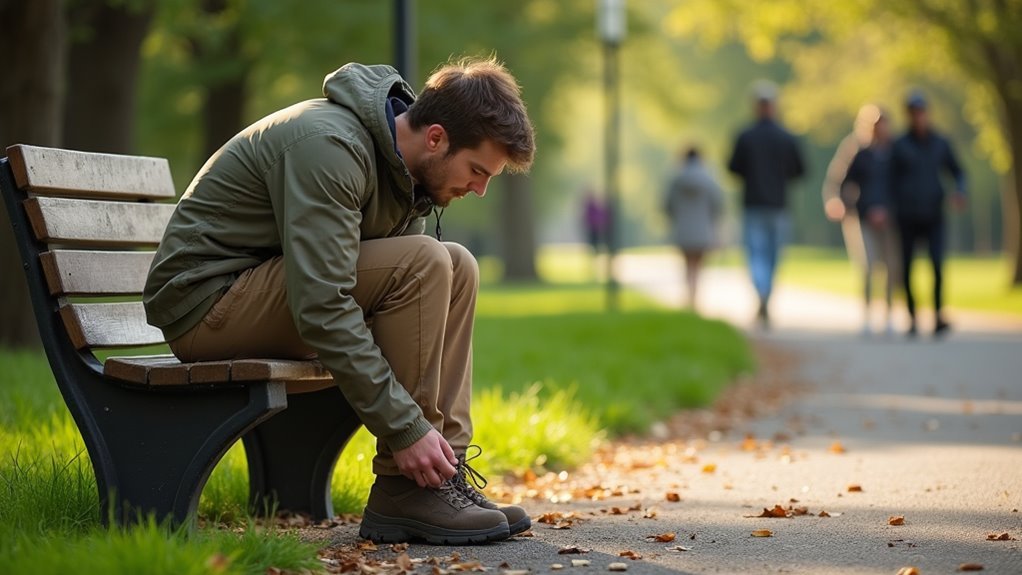Some of the links in this article may be affiliate links. If you make a purchase through these links, we may earn a small commission at no extra cost to you. Thank you.
I’ve been urban geocaching for almost a decade, and let me tell you—finding caches in busy city centers without looking suspicious is an art form. I’ve developed techniques that keep me virtually invisible while hunting those tricky urban hides. Whether you’re dodging curious onlookers at a bus stop cache or trying to look natural searching that suspicious lamp post, there’s always a way to blend in. Want to know how I’ve managed to find over 500 urban caches without a single muggle questioning me?
The Urban Geocaching Challenge

The worst is when you’ve finally spotted your target and—bam—a group of tourists stops right next to it.
In urban geocaching, your greatest skill isn’t navigation—it’s looking normal while doing something decidedly abnormal.
Stealth Techniques for Crowded City Environments
How exactly do you navigate through a sea of 8.4 million New Yorkers while trying to nonchalantly grab a tiny container hidden under a park bench?
I’ve perfected what I call Psychological Camouflage over years of urban caching.
Unlike Rural Discretion where you just need to watch for the occasional hiker, city stealth requires blending with purpose.
My top urban techniques that never fail:
- Pretend to text your mom while searching
- “Lock” your bike near the cache location
- Tie your shoe (works every single time)
- Act like you’re taking the perfect photo
- Bring a friend to create a distraction
- Pretend to text your mom when examining a suspicious spot – works every time!
- Lock your bike in a seemingly odd location as cover for your cache retrieval
- Tie your shoe (the classic move) when you need to reach low without questions
- Take photos in the direction of the cache while looking like a typical tourist
- Talk on your phone while discretely scanning potential cache locations
- Opt for breathable, moisture-wicking Fabric Innovations that keep you comfortable during extended hunts
- Layer with Seasonal Styles—I prefer a lightweight windbreaker in spring that I can adjust as needed
- Choose footwear with flexible soles that let you “tie your shoe” naturally near ground caches
- Invest in garments with hidden pockets—they’re worth every penny, trust me
- Add everyday accessories like a cap or sunglasses—these aren’t just for sun, they’re tactical tools
- Pretend to text while scanning for the cache
- Tie your shoe as cover for grabbing the container
- Lean against a wall like you’re waiting for someone
- Adjust your bag while retrieving the cache
- Drop something intentionally to search the ground
- Posting in the “How do I…?” subforum to meet locals (366.6k posts can’t be wrong!)
- Joining recent cache-specific threads like the GC1169 APE Cache discussion
- Trading trackables with city dwellers – those 622.2k posts represent real people
- Attending Group Meetups organized in specialty forums like Wherigo
- Participating in Community Events you’ll discover through these connections
These tricks work even better with Nighttime Invisibility, though I’d say daytime caching is actually more fun—you just need confidence.
Nobody questions someone tying their shoe!
Essential Gear for Discreet Cache Hunting

When I’m hunting caches in busy city spots, I’ve found that blending in is all about having the right everyday gear that doesn’t scream “I’m looking for something hidden!”
Your smartphone doubles as both navigation tool and perfect urban prop – nothing looks more normal than someone absorbed in their screen.
I always wear layers with plenty of pockets and comfortable shoes that can handle hours of walking, because in my experience, the right tactical clothing choices make all the difference between looking like a confused tourist and just another city dweller going about their day.
Everyday Camouflage Tools
Maneuvering through New York City’s sea of 8.4 million people while hunting for geocaches requires some serious stealth tactics if you don’t want to attract unwanted attention.
I’ve found that incorporating Daily Routines and Social Pretenses creates the perfect Environmental Masks for urban cache hunting.
These everyday behaviors help you blend right in, even in NYC’s busiest areas.
Urban Distraction Props
Ever wondered why some geocachers blend into the urban landscape while others stick out like a sore thumb? It’s all about the props! In my experience traversing NYC’s 8.4 million muggles, having the right distraction tools makes all the difference.
| Prop Type | Cultural Adaptations | Psychological Effects |
|---|---|---|
| Mobile Phone | Universal acceptance in cities | Creates personal bubble |
| Bicycle | Varies by neighborhood history | Justifies lingering behavior |
| Shoe Tying | Transcends historical contexts | Rarely triggers suspicion |
| Camera | Tourist-friendly areas | Redirects attention positively |
| City Maps | Aligns with local expectations | Projects authentic confusion |
I’ve found that these aren’t just modern inventions – they’re evolved forms of Historical Props people have used for centuries to justify their presence. Nothing works better than pretending to text my mom while secretly hunting that elusive cache!
Tactical Clothing Choices
Invisibility in urban geocaching isn’t about magic cloaks—it’s about strategic wardrobe choices.
I’ve found that Clothing Materials like neutral-colored fabrics are your best friends in NYC’s concrete jungle.
When you’re retrieving caches among 8.4 million rushing pedestrians, the right outfit makes all the difference.
Common Muggle Interactions and How to Handle Them

When you’re hunting for caches in bustling urban environments, you’re bound to encounter what we geocachers affectionately call “muggles” – non-geocaching civilians who might wonder why you’re poking around that lamp post or suspiciously eyeing a park bench.
In my experience, handling public curiosity is all about blending in.
When I feel those questioning looks in NYC, I’ll pretend to text my mom or tie my shoe—simple actions that don’t raise eyebrows.
Sometimes friendly interactions are unavoidable, like when someone approaches while you’re taking photos.
I’ve actually made some new friends this way!
Just position yourself strategically and engage in casual conversation.
If someone directly questions you, try my favorite tactic: act like you’re checking out a spot to lock your bike. Works every time!
Tactical Approaches for Different Cache Types
When I’m hunting for traditional caches in busy urban spots, I’ve learned the phone trick works wonders – I’ll pretend to text while carefully scanning that suspicious lamp post.
For multi-caches that have me zigzagging through crowded areas, I’ll sometimes stop to “check directions” on my phone when recording coordinates.
You’d be surprised how blending everyday actions with your geocaching makes even the trickiest urban hides manageable without attracting unwanted attention.
Traditional Cache Camouflage
Blending into the urban landscape requires mastery of traditional cache camouflage, especially when you’re hunting treasures among millions of potential onlookers in places like New York City.
I’ve found that the Historical Evolution of urban caching has taught us to become practically invisible.
Material Selection is essential—I once disguised a cache as part of a bike lock that nobody questioned for months!
For successful Environmental Integration in busy settings, try these stealth moves:
These simple actions let you grab caches without raising eyebrows—trust me, they work!
Multi-Cache Urban Navigation
Multi-cache expeditions through urban jungles require an entirely different tactical approach than their rural counterparts.
I’ve found that effective multi-cache planning starts with mapping routes that incorporate quieter side streets—this dramatically reduces muggle encounters while maintaining waypoint integration efficiency.
When I’m traveling between stages in places like NYC, I’ll often pretend to text while actually verifying coordinates.
It’s a simple trick that works wonders!
For Wherigo components, I always pre-test cartridges in less crowded areas first—trust me, you don’t want to troubleshoot with an audience.
My favorite navigation strategy? Blend geocaching with everyday activities.
I’ll tie my shoe to check a micro cache or incorporate cache hunting into my morning jog.
This natural movement pattern keeps muggles from getting, well, suspicious.
Building Your Geocaching Community in Metropolitan Areas
How do you find your tribe in a sea of 8.4 million strangers?
In my experience, the digital world is your best first step.
I’ve found incredible connections through Forum Networking on General Geocaching Discussions – it’s like a virtual campfire with 1.3 million conversation starters!
To build your metropolitan geocaching community, try:
Nobody should urban cache alone when millions of potential friends are just a forum post away.
Frequently Asked Questions
Is Geocaching Still a Thing in 2025?
I’m seeing geocaching thrive in 2025 with diverse participant demographics, continuous innovation trends, and strong future popularity indicated by active forums and regular platform updates.
Which Caching Strategy Would Best Improve Cache Hit Rates and Overall Performance?
I’d recommend pretending to text while searching in high-traffic areas. This cache optimization technique improves hit rates while appearing natural. My performance enhancements also include tying shoes or checking bike spots for seamless retrieval.
Is Taking Geocaches Illegal?
Like walking a tightrope, taking geocaches crosses ethical lines. Illegal removal can lead to legal consequences, depending on location and circumstances. I’d advise following community guidelines to avoid these troubles.
What Is the Most Found Geocache in the World?
I believe GC1169 “Project APE Cache – Tunnel of Light” ranks among the world’s most found IconicCaches, though exact FindRecords aren’t mentioned. Many GlobalMilestones in geocaching history feature this famous cache.